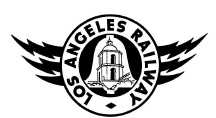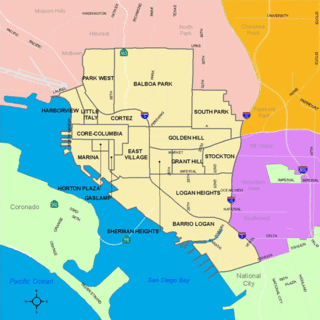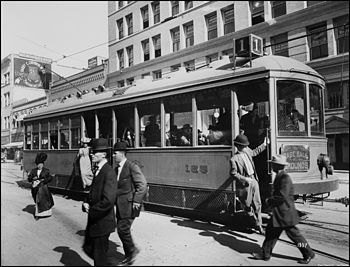
The Pacific Electric Railway Company, nicknamed the Red Cars, was a privately owned mass transit system in Southern California consisting of electrically powered streetcars, interurban cars, and buses and was the largest electric railway system in the world in the 1920s. Organized around the city centers of Los Angeles and San Bernardino, it connected cities in Los Angeles County, Orange County, San Bernardino County and Riverside County.

The Panama–California Exposition was an exposition held in San Diego, California, between January 1, 1915, and January 1, 1917. The exposition celebrated the opening of the Panama Canal, and was meant to tout San Diego as the first U.S. port of call for ships traveling north after passing westward through the canal. The fair was held in San Diego's large urban Balboa Park.
The St. Louis Car Company was a major United States manufacturer of railroad passenger cars, streetcars, trolleybuses and locomotives that existed from 1887 to 1974, based in St. Louis, Missouri.

The San Diego Trolley is a light rail system operating in the metropolitan area of San Diego. It is known colloquially as "The Trolley". The Trolley's operator, San Diego Trolley, Inc. (SDTI), is a subsidiary of the San Diego Metropolitan Transit System (MTS). The Trolley began service on July 26, 1981, making it the oldest of the second-generation light rail systems in the United States. The entire Trolley network serves 53 stations, and comprises 53.5 miles (86.1 km) of route, and three primary lines named the Blue Line, the Orange Line, and the Green Line, as well as a supplementary heritage streetcar downtown circulator known as the Silver Line that operates on select weekdays, weekends and holidays. In 2019, the Trolley was the 5th most-ridden light rail system in the United States, with 38,047,300 annual rides, an average of 117,700 rides per weekday.

The San Diego Electric Railway (SDERy) was a mass transit system in Southern California, United States, using 600 volt DC streetcars and buses.

Balboa Park station is a Bay Area Rapid Transit (BART) and Muni Metro station complex located south of Balboa Park in southern San Francisco, California. It is an intermodal hub served by four BART routes, three Muni Metro lines, and a number of Muni bus routes. The station complex also includes two rail yards, Cameron Beach Yard and Green Light Rail Center, where Muni maintains Muni Metro trains and heritage streetcars. BART uses a below-grade island platform on the west side of the complex; Muni Metro routes use several smaller side platforms located on surface-level rail loops around the yards.

The Los Angeles Railway was a system of streetcars that operated in Central Los Angeles and surrounding neighborhoods between 1895 and 1963. The system provided frequent local services which complimented the Pacific Electric "Red Car" system's largely commuter-based interurban routes. The company carried many more passengers than the Red Cars, which served a larger and sparser area of Los Angeles.

John Diedrich Spreckels, the son of German-American industrialist Claus Spreckels, founded a transportation and real estate empire in San Diego, California, in the late 19th and early 20th centuries. The entrepreneur's many business ventures included the Hotel del Coronado and the San Diego and Arizona Railway, both of which are credited with helping San Diego develop into a major commercial center.

Golden Hill is a neighborhood of San Diego, California. It is located south of Balboa Park, north of Sherman Heights/Highway 94, and east of Downtown.

University Heights is a neighborhood in Central San Diego, California centered on Park Boulevard and Adams Avenue. According to the City of San Diego Assessor/Recorder/County Clerk parcel maps, University Heights is bounded on the west and north by the edge of the mesa, the southern boundary is Lincoln Avenue, and the eastern boundary is Boundary Street along the western edge of Interstate 805. The area is filled with a number of restaurants, coffee shops, boutiques, and artist studios primarily on Park Boulevard and Adams Avenue. Live entertainment can be found most nights. Adjacent to Hillcrest, Normal Heights and North Park, additional restaurants, bars, coffee shops, and night clubs are within easy reach.

South Park is a neighborhood in San Diego, California adjacent to the southeast corner of Balboa Park. It stands out in San Diego for its tree-lined streets and walkable business district.

Spreckels Organ Pavilion houses the open-air Spreckels Organ in Balboa Park, San Diego, California. The Spreckels Organ is the world's largest pipe organ in a fully outdoor venue. Constructed for the 1915 Panama-California Exposition, it is located at the corner of President's Way and Pan American Road East in the park.

The Santa Fe Depot in San Diego, California, is a union station built by the Atchison, Topeka and Santa Fe Railway to replace the small Victorian-style structure erected in 1887 for the California Southern Railroad Company. The Spanish Colonial Revival style station is listed on the National Register of Historic Places. Its architecture, particularly the signature twin domes, is often echoed in the design of modern buildings in Downtown San Diego. A wing now houses the downtown branch of the Museum of Contemporary Art San Diego.

Downtown San Diego is the city center of San Diego, California, the eighth largest city in the United States. In 2010, the Centre City area had a population of more than 28,000. Downtown San Diego serves as the cultural and financial center and central business district of San Diego, with more than 4,000 businesses and nine districts. The downtown area is the home of the San Diego Symphony and the San Diego Opera as well as multiple theaters and several museums. The San Diego Convention Center and Petco Park, home of the San Diego Padres, are also located downtown. Downtown San Diego houses the major local headquarters of the city, county, state, and federal governments.

The San Diego Metropolitan Transit System is the public transit service provider for Central, South, Northeast and Southeast San Diego County. The agency directly operates a large transit system that includes bus, light rail, and bus rapid transit services. The MTS also controls the San Diego and Arizona Eastern (SD&AE) freight railway and regulates taxicabs, jitneys, and other private for-hire passenger transportation services provided by contract for the cities of San Diego, El Cajon, Imperial Beach, La Mesa, Lemon Grove, Poway and Santee.

Streetcars or trolley(car)s were once the chief mode of public transit in hundreds of North American cities and towns. Most of the original urban streetcar systems were either dismantled in the mid-20th century or converted to other modes of operation, such as light rail. Today, only Toronto still operates a streetcar network essentially unchanged in layout and mode of operation.

Balboa Park is a 1,200-acre (4.9 km2) historic urban cultural park in San Diego, California, United States. In addition to open space areas, natural vegetation zones, green belts, gardens, and walking paths, it contains museums, several theaters, and the world-famous San Diego Zoo. There are also many recreational facilities and several gift shops and restaurants within the boundaries of the park. Placed in reserve in 1835, the park's site is one of the oldest in the United States dedicated to public recreational use. Balboa Park is managed and maintained by the Parks and Recreation Department of the City of San Diego.

The Silver Line is a 2.7-mile (4.3 km) heritage streetcar line operated by the San Diego Trolley, an operating division of the San Diego Metropolitan Transit System. It currently operates the "downtown loop"; a circle of tracks around Downtown San Diego, and is operated using renovated historic vehicles. The line is also known as the SDG&E Silver Line after San Diego Gas & Electric (SDG&E), which has provided grants to help restore the streetcars and also sponsors a 3rd-grade history curriculum that includes free rides on the line. The line is one of four lines in the Trolley system, the others include the Blue, Orange, and Green lines.

The El Prado Complex is a historic district in Balboa Park in San Diego, California. The 13-acre (5.3 ha) complex includes 13 contributing buildings and one contributing structure. Most of the structures were built for San Diego's Panama-California Exposition of 1915–16 and were refurbished and re-used for the California Pacific International Exposition of 1935–36. The original architects were Bertram Goodhue and Carleton Winslow. The area was listed on the National Register of Historic Places in 1976.





















